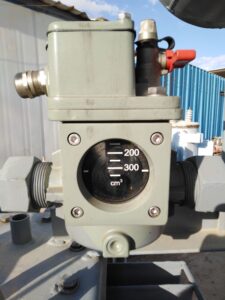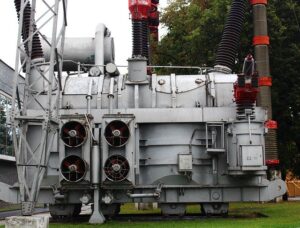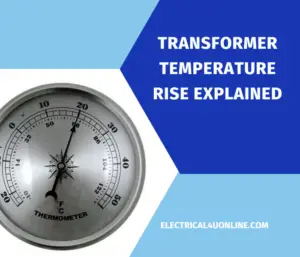
A Buchholz relay is a protective device commonly used in oil-filled transformers.
Its primary function is to detect and provide protection against incipient faults, such as the development of gas or excessive heat within the transformer oil.
The relay is named after its inventor, Max Buchholz, who introduced it in 1921.
It is commonly used for the protection of oil-immersed transformers that are filled with oil and are likely to get electrical surges over time.
These surges may end the transformer into a potential security threat to life and infrastructure near the transformers.
Buchholz relay, itself is inside a container filled with oil and this container and its oil are practically separate from the internal part of the transformer and its oil respectively.
Table of Contents
What type of relay is the Buchholz relay?
The Buchholz relay is a specialized type of protective relay used in conjunction with oil-filled transformers.
It is specifically designed to protect against various types of faults that may occur within the transformer.
The Buchholz relay is considered a gas and oil-operated relay due to its operating principle, which involves the detection of gas and oil flow changes within the transformer.
The relay contains a float that is sensitive to the presence of gas or significant oil flow variations. When certain faults, such as internal arcing or overheating, occur in the transformer, they can generate gas or cause turbulence in the oil.
The Buchholz relay detects these changes and triggers alarms or initiates a protective trip to shut down the transformer.
So, to summarize, the Buchholz relay is a specific type of gas and oil-operated relay designed for transformer protection.
Buchholz relay working principle
The Buchholz relay operates based on the principle of detecting changes in the oil and gas conditions within an oil-filled transformer.
It is designed to provide protection against various faults, particularly those that result in the generation of gas or abnormal oil flow. Here’s an overview of the working principle of the Buchholz relay:
- Float Mechanism: The Buchholz relay contains a float with a hinged mechanism. This float is typically located in the piping connecting the main oil tank and the conservator tank of the transformer.
- Oil Flow and Gas Accumulation Detection: Under normal operating conditions, the transformer oil circulates between the main tank and the conservator tank in a relatively stable manner. However, when certain faults occur within the transformer, they can lead to changes in the oil conditions.
- Incipient Faults Detection: The Buchholz relay is particularly sensitive to incipient faults, such as:
- Gas Accumulation: The relay is designed to detect the accumulation of gas within the transformer oil. This can happen due to internal arcing, partial discharges, or other types of faults.
- Abnormal Oil Flow: The relay can also detect abnormal oil flow caused by factors like overheating, which may lead to increased oil turbulence.
- Tilting of the Float: When gas bubbles or abnormal oil flow occurs, the float inside the Buchholz relay tilts. The tilting of the float is proportional to the severity of the fault.
- Contact Activation: As the float tilts, it activates contacts within the relay. There are typically two sets of contacts:
- Alarm Contacts: These contacts are activated when the fault is at an early stage. They are used to signal an alarm, alerting operators to a potential issue in the transformer.
- Trip Contacts: If the fault worsens or becomes severe, the trip contacts are activated. These contacts initiate a protective trip, shutting down the transformer to prevent further damage.
The Buchholz relay’s ability to detect incipient faults and provide both alarm and tripping functions makes it a crucial component in the protection scheme of oil-filled transformers.
It helps prevent catastrophic failures and ensures the safety and reliability of the transformer and the overall power system.
Read also my article Transformer Most Common Faults
Uses of Buchholz relay
The Buchholz relay is a critical protective device used in oil-filled transformers to detect and respond to various faults and abnormal conditions.
Its primary purpose is to enhance the safety and reliability of the transformer and the power system. Here are some key uses of the Buchholz relay:
- Detection of Incipient Faults: The Buchholz relay is specifically designed to detect incipient faults within the transformer. Incipient faults are early-stage faults that may lead to more serious issues if not addressed promptly. The relay can detect phenomena such as gas accumulation or abnormal oil flow, which may indicate internal problems like partial discharges, arcing, or overheating.
- Early Warning System: The relay provides an early warning by activating alarm contacts in response to the detection of incipient faults. The alarm signals alert operators or monitoring systems to the presence of a potential issue in the transformer. This allows for proactive maintenance or investigation to prevent further damage.
- Prevention of Catastrophic Failures: In the event that the fault progresses and reaches a critical level, the Buchholz relay activates trip contacts. These contacts initiate a protective trip, disconnecting the transformer from the power system. This action prevents catastrophic failures and extensive damage to the transformer and associated equipment.
- Enhanced Transformer Safety: By monitoring and responding to internal faults, the Buchholz relay contributes to the overall safety of the transformer. This is particularly important in preventing events such as transformer explosions or fires that can pose risks to personnel and equipment.
- Reduced Downtime and Maintenance Costs: Early detection of faults allows for timely maintenance and repairs, reducing the risk of unplanned outages and minimizing downtime. Proactive maintenance based on Buchholz relay alarms helps extend the operational life of the transformer and reduces overall maintenance costs.
- Compliance with Industry Standards: Buchholz relays are commonly used in oil-filled transformers and are often required by industry standards and regulations. Compliance with these standards ensures that transformers meet safety and reliability requirements.
In summary, the Buchholz relay plays a crucial role in transformer protection by detecting incipient faults, providing early warnings, and initiating protective measures to prevent catastrophic failures. Its use enhances the overall reliability and safety of power distribution systems.
Is the Buchholz Relay an overcurrent relay?
No, the Buchholz relay is not an overcurrent relay. The Buchholz relay is a protective relay designed specifically for the detection of faults and abnormal conditions within oil-filled transformers.
It operates based on the changes in oil and gas conditions within the transformer rather than monitoring electrical currents.
The primary function of the Buchholz relay is to detect incipient faults, such as internal arcing, partial discharges, or overheating, that may lead to more severe issues if not addressed promptly. It achieves this by sensing the presence of gas or changes in oil flow within the transformer oil.
In contrast, overcurrent relays are a type of protective relay that monitors the electrical current flowing through a circuit.
They are designed to detect overcurrent conditions, which could result from short circuits, ground faults, or other electrical abnormalities.
Overcurrent relays are commonly used in power systems to trip circuit breakers or disconnect equipment in the event of excessive current flow.
While both Buchholz relays and overcurrent relays are protective devices used in power systems, they serve different purposes and operate based on different principles to safeguard transformers and electrical circuits, respectively.
At which angle is a Buchholz relay fixed?
The Buchholz relay itself is not fixed at a specific angle; rather, it contains a float mechanism inside that tilts when certain conditions are detected.
The float is hinged and positioned within the oil flow path between the main tank and the conservator tank of the transformer.
When a fault occurs within the transformer, such as the generation of gas due to internal arcing or abnormal oil flow, the float tilts in response to the changes in oil and gas conditions.
The angle of tilt is not standardized and can vary depending on the design and specifications of the specific Buchholz relay and transformer.
Manufacturers may provide information on the relay’s sensitivity and the corresponding tilt angle in the product documentation.
Why are mercury switches used in the Buchholz Relays?
It’s important to clarify that, in standard Buchholz relays, mercury switches are not used.
Buchholz relays typically employ mechanical contacts, rather than mercury switches, for the alarm and trip functions.
The float inside the Buchholz relay is connected to mechanical contacts. When the float tilts due to the presence of gas or other anomalies in the transformer oil, it activates these contacts. The contacts are typically designed to be robust and reliable, allowing for the proper signaling of alarms or initiating a trip signal.
Mercury switches were more commonly used in some types of relays and switches in the past, but due to environmental and health concerns associated with mercury, there has been a move away from its use in many applications, including relays.
If you have specific information about a Buchholz relay using mercury switches, it might be a unique or specialized design, and you should refer to the product documentation or contact the manufacturer for accurate details on the relay’s construction and components.
However, in standard Buchholz relays, mercury switches are not a common or standard component.
Why Buchholz relay is called a gas-actuated relay?
The Buchholz relay is often referred to as a “gas-actuated relay” because it operates based on the presence of gas within the transformer oil.
It is designed to detect faults and abnormal conditions within oil-filled transformers, and one of its primary functions is to respond to the generation of gas as a result of various internal faults.
Here’s how the gas-actuated principle works in the Buchholz relay:
- Gas Accumulation Detection: When certain faults occur inside the transformer, such as internal arcing or partial discharges, they can generate gases. Additionally, overheating can also lead to the release of gases from the insulating oil. The Buchholz relay is sensitive to these changes.
- Float Mechanism: The relay contains a hinged float positioned within the oil flow path between the main tank and the conservator tank of the transformer. When gas accumulates due to a fault, the gas rises to the top of the relay.
- Float Tilt: As gas accumulates, the float tilts in response to the rising gas. The tilt of the float is proportional to the severity of the fault or the amount of gas generated.
- Contact Activation: The tilting of the float activates mechanical contacts within the relay. These contacts are connected to the alarm and trip circuits. The alarm contacts are triggered when the fault is at an early stage, indicating a potential issue. The trip contacts are activated in more severe conditions, initiating a protective trip to disconnect the transformer from the power system.
So, the term “gas-actuated relay” highlights the Buchholz relay’s ability to respond to the presence of gas as an indicator of internal faults within the transformer.
This distinctive feature makes the Buchholz relay a crucial component in the protection scheme for oil-filled transformers, providing early detection and prevention of potentially catastrophic failures.
What type of fault does Buchholz relay employ for?
The Buchholz relay is designed to respond to specific types of faults and abnormal conditions that may occur within oil-filled transformers.
It is particularly sensitive to incipient faults, which are early-stage faults that have the potential to develop into more severe issues if not addressed promptly. The primary faults and conditions that the Buchholz relay is designed to detect include:
- Internal Arcing: When an arc occurs inside the transformer, it can generate gases. The Buchholz relay is sensitive to the accumulation of gas, which is an indication of internal arcing.
- Partial Discharges: Partial discharges within the transformer can also lead to the generation of gas. The Buchholz relay can detect the presence of gas caused by partial discharges.
- Overheating: Excessive heat within the transformer can lead to the degradation of insulating materials and the release of gas. The Buchholz relay is responsive to abnormal oil flow or gas accumulation caused by overheating.
- Faulty Windings: If there is a fault in the windings, such as a short circuit or insulation failure, it can lead to the generation of gas. The Buchholz relay can detect gas related to faults in the windings.
- Oil Flow Anomalies: Changes in the oil flow pattern, such as rapid or turbulent oil flow, can indicate a fault or abnormal condition. The Buchholz relay is sensitive to such oil flow anomalies.
The Buchholz relay’s ability to detect gas and respond to these specific fault conditions makes it a valuable component in the protection scheme for oil-filled transformers.
By providing early warning through alarm signals and initiating protective trips in more severe conditions, the Buchholz relay helps prevent catastrophic failures and ensures the safety and reliability of the transformer and the power system.
How many Buchholz relays are used in a transformer?
The number of Buchholz relays used in a transformer depends on the transformer’s design, size, and specific requirements.
In many cases, a transformer may have one Buchholz relay installed, typically in the piping between the main tank and the conservator tank.
For smaller transformers or transformers with lower ratings, a single Buchholz relay might be sufficient to monitor the entire unit.
However, for larger transformers or transformers with multiple compartments, there could be multiple Buchholz relays installed.
In some complex transformer configurations, where there are separate compartments or sections with independent oil circulation systems, each compartment might have its own Buchholz relay. This allows for more precise monitoring of different parts of the transformer.
The key purpose of the Buchholz relay is to detect faults and abnormal conditions within the transformer oil.
Its placement and the number of relays depend on the transformer’s construction, and the relay locations are typically determined during the transformer design phase.
It’s important to consult the transformer’s technical documentation or specifications to determine the specific number and configuration of Buchholz relays used in a particular transformer.
The transformer manufacturer or the entity responsible for the transformer’s maintenance can provide accurate information regarding the number and location of Buchholz relays for a specific transformer model.
Buchholz relay alarm and trip functions
The Buchholz relay provides two main functions: alarm and trip. These functions are crucial in the protection scheme of oil-filled transformers, helping to detect and respond to various faults and abnormal conditions. Here’s how the alarm and trip functions work in a Buchholz relay:
- Alarm Function:
- Gas Accumulation or Oil Flow Anomalies: When the Buchholz relay detects incipient faults such as internal arcing, partial discharges, or abnormal oil flow, it responds by tilting its float mechanism. This tilt is proportional to the severity of the fault.
- Contact Activation: As the float tilts, it activates the alarm contacts within the relay. These contacts are part of the alarm circuit.
- Alarm Signal: The activation of the alarm contacts triggers an alarm signal. This signal can be used to alert operators or monitoring systems that there is a potential issue within the transformer.
- Early Warning: The alarm function provides an early warning, allowing for proactive investigation and maintenance to address the detected fault before it develops into a more serious problem.
- Trip Function:
- Severe Fault Conditions: If the fault within the transformer worsens or reaches a critical level, the float tilts further.
- Trip Contacts Activation: The additional tilt of the float activates the trip contacts within the relay. These contacts are part of the trip circuit.
- Protective Trip: The activation of the trip contacts initiates a protective trip. The trip signal is sent to the transformer’s protective relay or circuit breaker, leading to the disconnection of the transformer from the power system.
- Catastrophic Fault Prevention: The trip function is designed to prevent catastrophic failures by isolating the transformer from the power system when severe faults are detected.
In summary, the Buchholz relay’s alarm function provides an early warning for potential issues within the transformer, while the trip function initiates a protective trip in more severe conditions to prevent extensive damage.
These dual functions contribute to the overall protection of oil-filled transformers and the reliability of power distribution systems.
Install my Free Android App on Google Play:
Electrical Cables Most Common Tables
And, my Electrical Calculations App “”
Discover more great content by subscribing to My channel
Looking to stay ahead of the game in the world of electrical engineering? Subscribe to my YouTube channel and gain access to exclusive content you won’t find anywhere else!
The staff I recommend
(Amazon Affiliate Links to products I believe are high quality):
- Economy 120 Volt/60Hz AC Power Source – Step-Down Voltage & Frequency Converters 1800W
- UNI-T Digital Multimeter Tester UT139C
- 50-Amp Extension Cord for RV “100ft”
- Voltage Stabilizer 110/220v
- Hair Dryer “best selling“
- TOSHIBA EM131A5C-BS Countertop Microwave Ovens
Disclaimer: This contains affiliate links to Amazon products. I may earn a commission for purchases made through these links.




